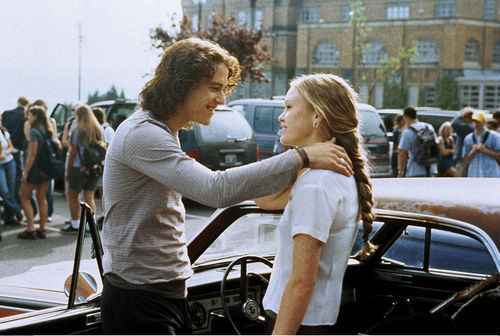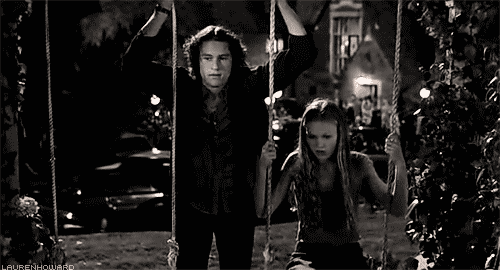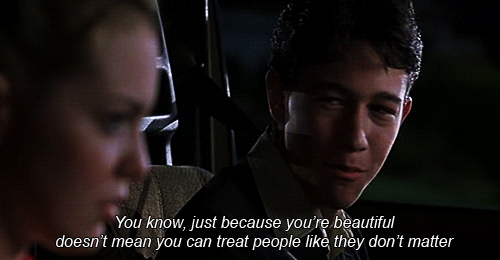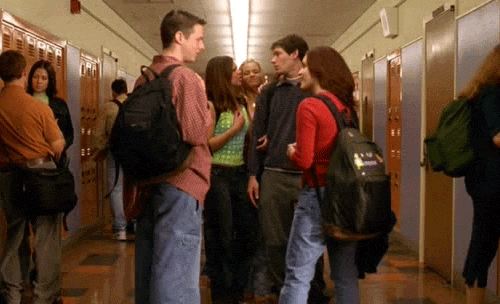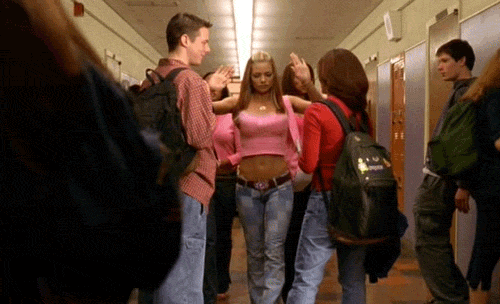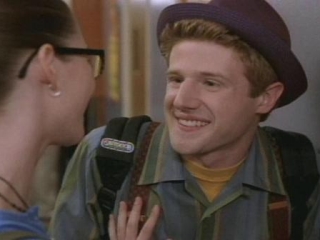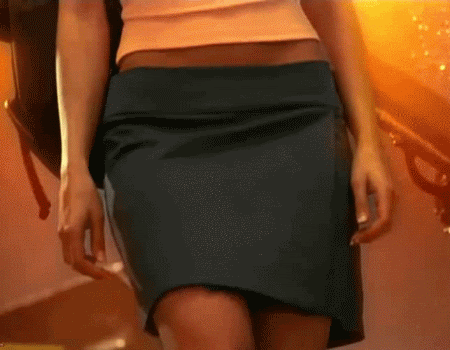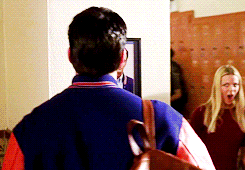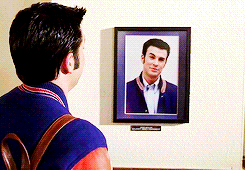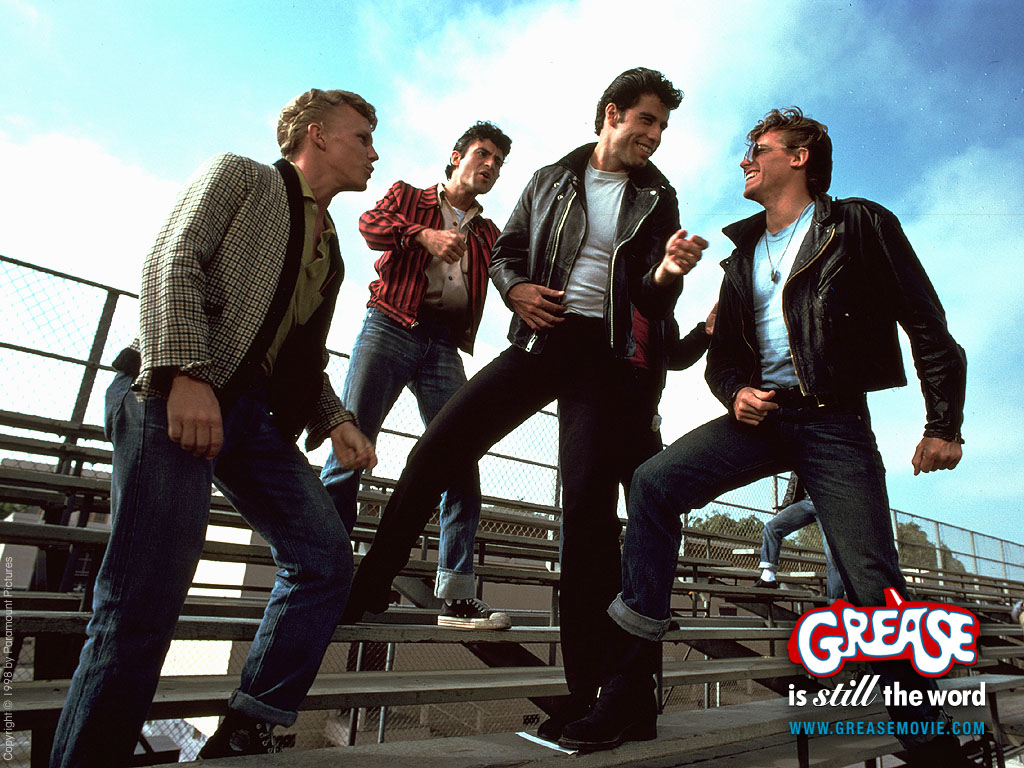Conventions
In 10 things I hate about you we found various conventions that we could come across in teen movies as well. We have the perfect girl, the jerk, the geeks, parent and kid relationship. We also come across the typical over strict and disciplined parent that tries to control his their kids life when realising they're growing up. Also the prom which is another typical one, that the kiss, romantic things, fights and the even the break ups. It is the transformation of the ugly ones that turn out to be actually pretty.
The typical settings are the car park in front of the school, the house party that everyone gets drunk and kisses in.
Friday 20 December 2013
reflective post
reflective post :
i feel that i am up to date with most of the the work set in class. i am satisfied with my blog post. i feel that i can improve my work by a broader variety of technology such as prezi and slide share.
i also feel that if i was to graded out of 20 i would reach a minimum of 17. i feel that later on in the course i can use my knowledge and wide experiences of using technology to enhance my blog.
i feel that i am up to date with most of the the work set in class. i am satisfied with my blog post. i feel that i can improve my work by a broader variety of technology such as prezi and slide share.
i also feel that if i was to graded out of 20 i would reach a minimum of 17. i feel that later on in the course i can use my knowledge and wide experiences of using technology to enhance my blog.
Conventions of teen movie
Teen Movie:10 Things I Hate About You
Recognised binary oppositions:
- Parents & Children
- Male & Female
- Love & Hate
- Pretty & Ugly
- Fun & Boring
- Teachers & Students
- Good & Bad
- Popular & Outcast
- Unique Cliques - {Geeks, dumb, rich, popular/perfect (both sex)...}
- Clever & Dumb
Conventional themes introduced:
- Prom
- House party
- School corridor
- Sports track
- Car park - establish shot of school
- Music - to define each character
- Class room
- Bed room
- School entrance
- High school
- Night club
- Canteen
Conventional characters involved in movie:
- The perfect girl 'Bianca' - Bright colour taste in fashion, has an untouchable status, beautiful, highly popular and very stylish
- Bianca's mean best friends 'Chasity' - Dumb, stuck up, mean, highly fashionable, always presents herself as a very nice person which she later is not, two faced and is very stylish
- The beautiful weirdo 'Patrick' - Mild fashion, most of the time miss judged, flirty and fragile
- The geek friend 'Michael' - Old fashioned clothing, very clever, greasy hair, unpopular and disliked with a low status
- The ugly girl 'Kat' - Unique personality, dark person with dark fashion, very clever, Rough look, has a great deal of history at High school
- Kat's best friend 'Mandela' - Unconventional fashion and style, severe obsession and a unique personality
- The normal guy 'Cameron' - Regular clothes, almost seems undefinable in terms of personality and traits as everything seems regular, fierce status and respected
- The dumb rich guy 'Joey' - Rich taste in fashion and style, rich, very popular, high status, very mean and self attracted with a bizarre personality
Here is an insight of the characters from the teen film:
10 THINGS I HATE ABOUT YOU : MOVIE REVIEW
conventions on teen movie :
"10 things i hate about you " is a teen romantic - comedy film. It is directed by gill junger and stars julia stiles and heath ledger. the film is a modernisation of Shakespeare's the ' taming of the shrew. The film was released march 31 , 1999 and was a breakout success for stars stiles and ledger.
conventions in the movie :
theme :
conventions on teen movie :
"10 things i hate about you " is a teen romantic - comedy film. It is directed by gill junger and stars julia stiles and heath ledger. the film is a modernisation of Shakespeare's the ' taming of the shrew. The film was released march 31 , 1999 and was a breakout success for stars stiles and ledger.
conventions in the movie :
theme :
- prom
- house party
- car park
- sports pitch
- established shot of the school
conventional characters :
- the geeks
- the rich kid
- the beautiful weird kid
- pretty/ugly girl
- the perfect girl
- the bestfriend
binary oppositions :
- parents and kids
- students and teachers
- male and females
- pretty and ugly
other important factors :
- music was used to define "the perfect girls" entrance
- the main instigator of the movie is the "wannabe"
Wednesday 18 December 2013
Representations through stereotypes
Character stereotypes from teen movies
I have analysed a few team movies to see how stereotypes have been constructed through various characters whether they play multiple roles or feature in different films representing different stereotypes. Here are some examples:
1. The Popular cheerleader 'Priscilla':
- Presented as mean and the most popular girl in high school, rich, undisputed status as well as dating the most popular boy from the jocks group
- Has blue eyes, blonde hair shown as very feminine by always being related to pink in some senses like a Barbie doll
- Wears highly fashionable clothes e.g. mini short skirt, belly tops, tightly fitted trousers and so on to show off her breasts and so called beautifully curved slim physique
- She owns a sports car showing off that she is a top girl and has pretty much everything she desires assuming herself as perfect
2. The desperate virgin:
- Clearly indicated and represented as desperate and is looking for sexual activity whether or not the girl has a high status or a normal average girl
- Normally appeared as a member of the geeks tagged as 'wannab's' therefore unpopular
- Obsessed with sexual activity and is seen spying on girls in the changing rooms
- Spends a lot of time in the toilet
3. The geeks:
- Identified and represented as clever, highly unpopular, victim of being bullied and have very rich geeky smart taste in clothing e.g. massive glasses, 3 quarter trousers belted just above their belly button with shirt tucked in
- Are attracted to the popular girls therefore gets used by the mean girls and gets exposed
- Always carry books with them and seen as very successful in their subjects especially science which is their favourite subject
- Always shown as hard working and organised students
4. The perfect girl 'Amanda':
- Majority of the time represented as beautiful, lonely, clever and pure
- Has nice combed hair and glowing bright white teeth with a natural fit physique
- There is a golden bright shiny light behind her when she is introduced coming down the stairs in slow motion to show her angel like and purified status, extremely attractive and most beautiful girl in general even though she is not very popular
5. The jocks 'Jake':
- Represented as rich, very popular, not very mean, shows off, attention seeker, has an undisputed status in high school and dates the most popular girl
- Has blue eyes, nice styled pulled back greasy hair, very fashionable with all the latest trends in clothes e.g. trainers and baseball jacket even has the name jocks on it seemingly as very cool
- Is introduced with rock music
- Likes american football and has teachers getting in his way even without an valid excuse or problem falling for his status and looks.
Representations: Characters from different movies
A stereotype is a thought that may be adopted about specific types of individuals or certain ways of doing things. These thoughts or beliefs may or may not accurately reflect reality.
I will be analysing the movie 'Not Another Teen Movie'. The stereotypes in this film are:
A stereotype is a thought that may be adopted about specific types of individuals or certain ways of doing things. These thoughts or beliefs may or may not accurately reflect reality.
I will be analysing the movie 'Not Another Teen Movie'. The stereotypes in this film are:
- Popular Jack
- Token Black Guy
- Cruelest Girl
- Popular Girl
- The boring girl that transforms
- The Virgin
- Obsessed best friend of popular girl
- The Geeks
The popular guy Jack is represented as handsome, the rich one that owns the school, usually dates the popular girl and is usually the one that plays for the schools football/basketball and is mainly the captain of this group.
The popular girl is represented with an obsessed best friend as well. The popular girl dates the popular boy, usually wears short skirts and low cut tops to express cleavage to everyone else, full on make up. Usually hangs around in her small group. The obsessed girl of the best friend that always copies her and is always next to her and agrees and backs up anything she says.
The boring girl that transforms is a girl thats normally in her own world that just studies and works, is not really allocated with another group. However when theres a party or end of year graduation this girl transforms into a hot girl that the popular guy is interested into after because he's never actually seen her.
The virgin is always the one that adores the popular and hot girl, is always trying to be seen by them and tries his best. Is usually a member of the geeks or wannabes and is obsessed by sex and is sometimes spotted spying on the girls in the changing rooms.
The geeks usually have their own group that they hang around with in the canteen with books. Always have books and are stereotyped as wearing glasses to show their hard work. Usually the cruelest girl that tries to sexualise him and uses him.
Representations: characters from different movies
stereotypes are often elaborate exaggerations. representations use stereotypes to convey ideas about "types" of characters. costume, music and other features of mise en scene have been used to represent stereotypes specific characters. for example1. The 'popular' cheerleader.
- usually represented as bossy
- athletic
- desperate to get attention
- wear short skirts and tight tops
- and are usually dating ' the football captain' of the team they support
- usually trying to fit in with the 'popular' people
- usually greet people like 'the jocks' when they walk through the main entrance
- full of information and ideas when difficult situations appear
- tries to hard ( in terms of fashion and whats on trend in school).
3. The 'Geeks'
- usually get bullied by the 'jocks' and often laughed at
- are usually attracted to the popular girls
- love science
- do all their homework on time and make robots in their spare time
- wear glasses and are smartly dressed
- usually a member of the 'geek' or 'wannabe's'
- usually attracted to the 'popular girls , perfect girl or cheerleaders'
- obsessed with sex
- usually spy's on the girls in the changing rooms
- spends a long time in the bathroom
5. The 'jocks'
Friday 13 December 2013
Romeo Juliet - Binary Oppositions
Romeo & Juliet
There are many binary oppositions during Romeo & Juliet (1996) on the opening scene. The two rivals the Montagues and Capulets are presented in different ways. The Montagues are dressed very bright with open shirts, that seem casual and colourful. However on the other hand the Capulets are wearing smart suits and dark colours like navy and black. The capulets also seem to present their suits as they're brave and calm unlike the montagues that are cowardly, nervous and do silly things behind the capulets instead of their face and ask for peace however capulets do not agree and create a war. The montagues seem more if tramps and hood boys wearing dog tags whereas the capulets are wearing real gold/bling. The capulets could also rely on their body for being so brave as they seem fit and muscular whereas the montagues seem chubby and unfit. They're also two different types of Americans, the montagues are the White Americans and the capulets are the Latin Americans.
Binary Oppositions
Binary opposition is when two opposites are strictly defined and faced off against each other. It is the between two mutually exclusive terms, such as on and off, up and down, left and right.
There were many binary oppositions in Romeo and Juliet:
There were many binary oppositions in Romeo and Juliet:
Binary oppositions :
complete contrasts in order to construct a narrative within a text. the use of binary opposition within visual codes is usually when introduces 2 new characters or groups.
Binary oppositions in Romeo and Juliet :
Montague :
Binary oppositions in Grease:
complete contrasts in order to construct a narrative within a text. the use of binary opposition within visual codes is usually when introduces 2 new characters or groups.
Binary oppositions in Romeo and Juliet :
Montague :
- bright coloured clothing and cars
- act cowardly and nervous at times
- want "peace"
- dress casual
- white american
- portrayed as the "poor"
- act reckless and are often loud
- dark coloured clothing/ dress smart in suits
- have a 'cowboy' look
- latin america
- act civil but don't like 'peace'
- act brave and strong
- often aggressive and are portrayed as 'rich'
binary opposition is mainly shown through differences in gender.
Binary Oppositions
Binary oppositions established in the opening of teen films
Binary Opposition: Complete contrasts, in order to construct a narrative within a text. Texts are organised around sets of opposite values such as good and evil, light and dark.
Here is a list of some of the binary oppositions I have seen today from teen films whether they are from this century or back in the 90's and beginning of 2000's:
- Rich/Poor
- War/Peace
- Various clicks
- Fashion in clothing.g. dark black leather suits vs pastel coloured bright jackets
- superhuman e.g. vampire/wolf/humans/zombies
- Outsiders/Insiders
- Parents/Kids
- Dry/Wet
- Mum/Dad
- Brave/Cowards
- Dark/Light
- Rivalry between groups representing different Values e.g. Montagues vs the Capulets
One of the major and excellent examples of binary oppositions come from the famous Romeo & Juliet as well as the Grease film and many more.
Romeo & Juliet:
This is one of the many movies that conveys binary opposition established mainly and start from the opening scene. For example in the opening scene the White American Montagues are introduced driving a bright sun yellow convertible 1988 Chevrolet C/K-Series in hawaiian style clothing (shirt and shorts) with coloured hair and a unique hip hop beat playing in the background which represents them in contrast to the Latin American Capulets who are driving a dark blue 1981 Chevrolet Monte Carlo Customized in sophisticated armed suits and buckle boots with rivalry cowboy music in the background. the Montagues were shown as hyperactive, happy, fun, scared and maybe vulnerable indirectly whereas the Capulets were shown as confident, frightening, rich and big muscular men. The theme sound for each of these groups gets cut off mainly the Montagues to indicate the dominance and powerful presence of the Capulets but when the Montagues are somewhere else maybe safe location seemingly their unique identity music plays in the background and so forth. In summary the two groups representing families have colour code such as Red for Capulets and Blue for Montagues.


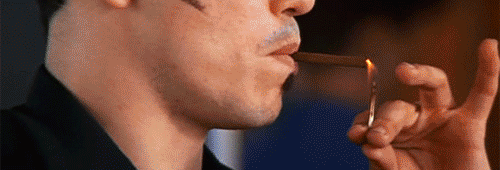
Grease:
This is another money which coveys binary oppositions in the opening of the scene. The opening scene starts off with a series of couples making out on beaches having quality time then instantly out of the blue we see the all the oppositions and stereotypes of both genders. There is also a lengthy cartoon insight of the stereotypes and oppositions taking place representing the characters for example Danny is seen with a messy bedroom, very untidy and with a grizzly face and frizzy hair in contrast to sandy who wakes up looking beautiful and perfect with a very clean and tidy room like she never even slept. Further in the opening scene we see two groups male and female called T-birds and Pink Ladies which we find in a school environment. We also see other groups from vulnerable to popular and so on showing plenty of binary oppositions. For example Popular cool boys (T-birds) bullying the vulnerable Geeks.
Romeo & Juliet:
This is one of the many movies that conveys binary opposition established mainly and start from the opening scene. For example in the opening scene the White American Montagues are introduced driving a bright sun yellow convertible 1988 Chevrolet C/K-Series in hawaiian style clothing (shirt and shorts) with coloured hair and a unique hip hop beat playing in the background which represents them in contrast to the Latin American Capulets who are driving a dark blue 1981 Chevrolet Monte Carlo Customized in sophisticated armed suits and buckle boots with rivalry cowboy music in the background. the Montagues were shown as hyperactive, happy, fun, scared and maybe vulnerable indirectly whereas the Capulets were shown as confident, frightening, rich and big muscular men. The theme sound for each of these groups gets cut off mainly the Montagues to indicate the dominance and powerful presence of the Capulets but when the Montagues are somewhere else maybe safe location seemingly their unique identity music plays in the background and so forth. In summary the two groups representing families have colour code such as Red for Capulets and Blue for Montagues.



Grease:
This is another money which coveys binary oppositions in the opening of the scene. The opening scene starts off with a series of couples making out on beaches having quality time then instantly out of the blue we see the all the oppositions and stereotypes of both genders. There is also a lengthy cartoon insight of the stereotypes and oppositions taking place representing the characters for example Danny is seen with a messy bedroom, very untidy and with a grizzly face and frizzy hair in contrast to sandy who wakes up looking beautiful and perfect with a very clean and tidy room like she never even slept. Further in the opening scene we see two groups male and female called T-birds and Pink Ladies which we find in a school environment. We also see other groups from vulnerable to popular and so on showing plenty of binary oppositions. For example Popular cool boys (T-birds) bullying the vulnerable Geeks.
Subscribe to:
Posts (Atom)
